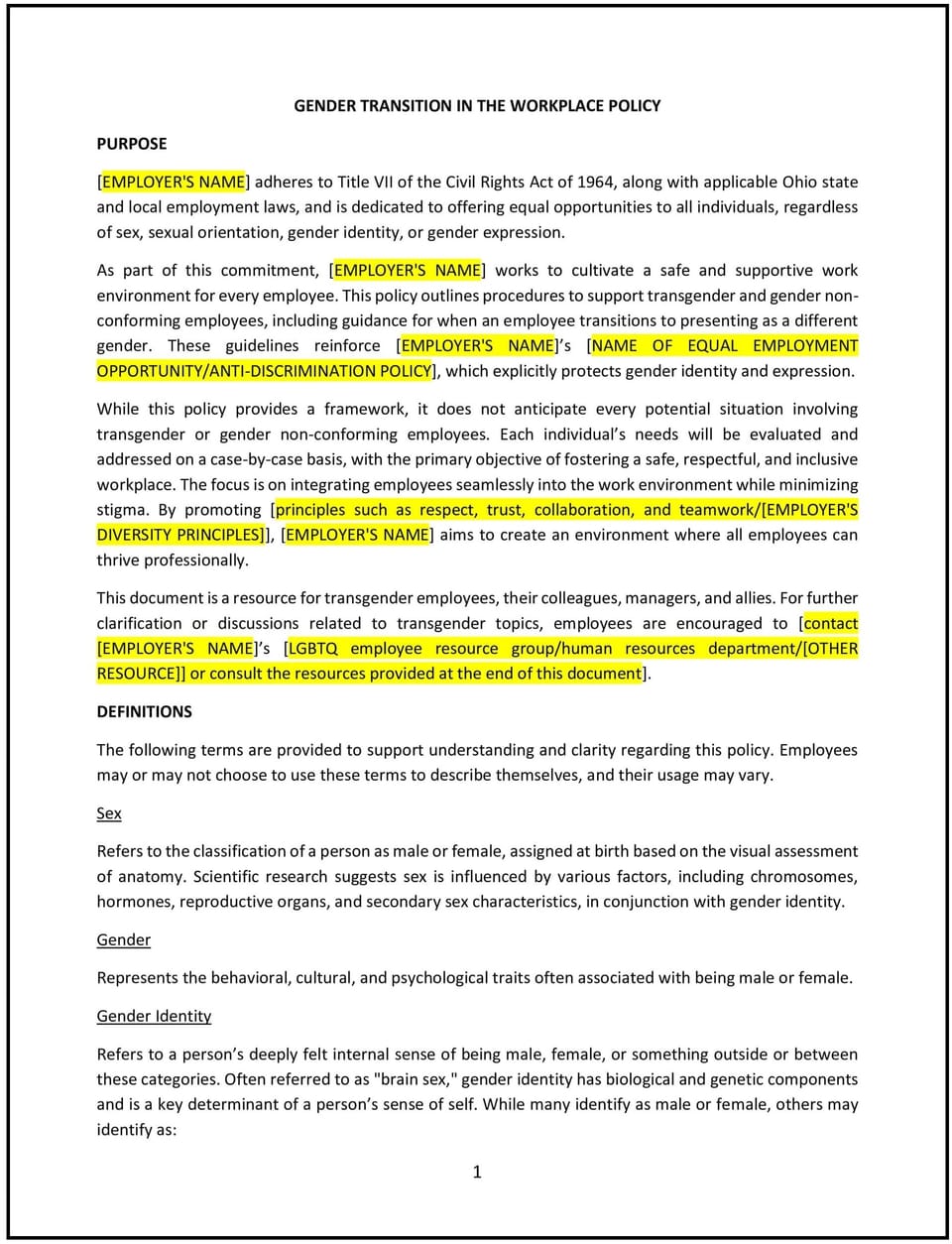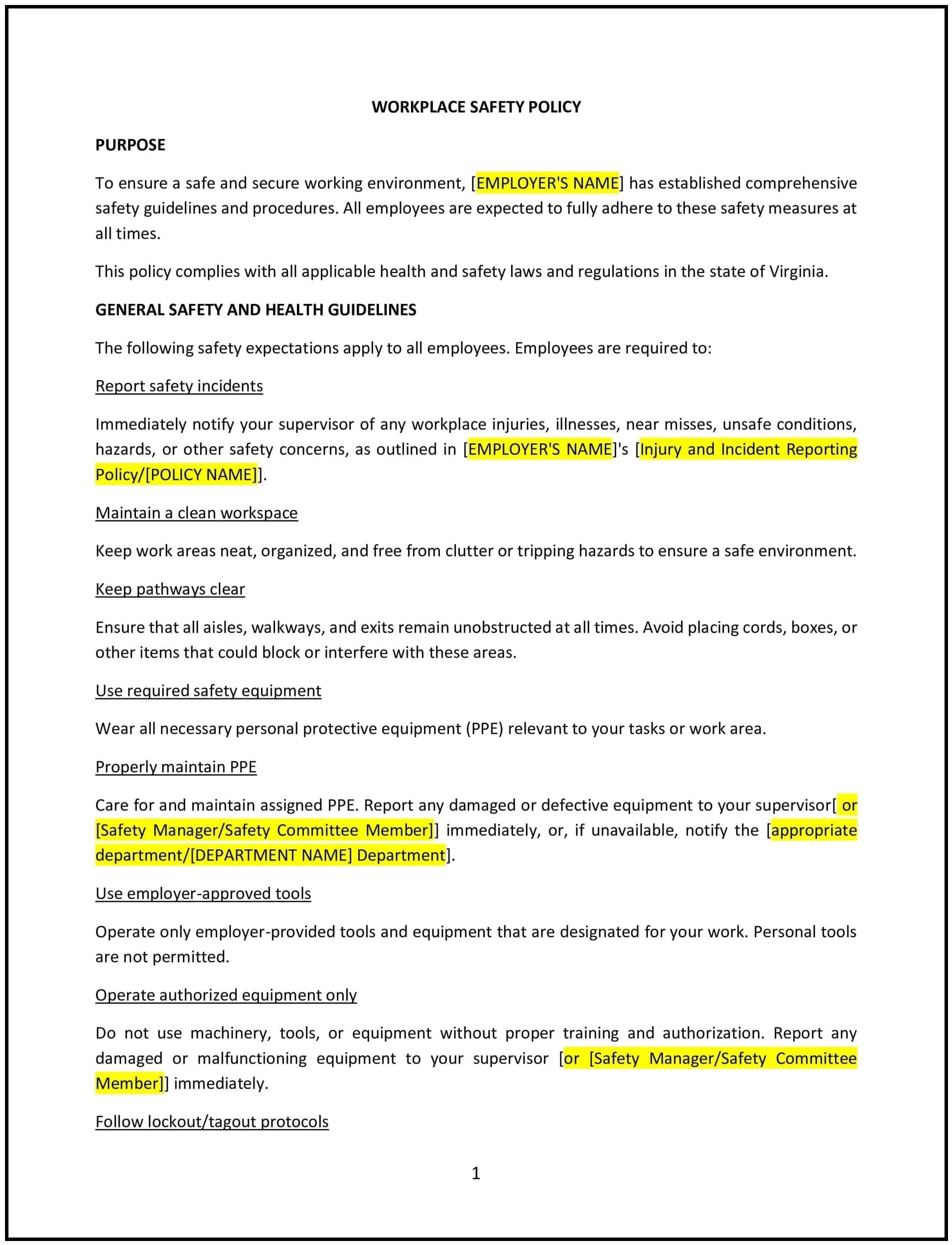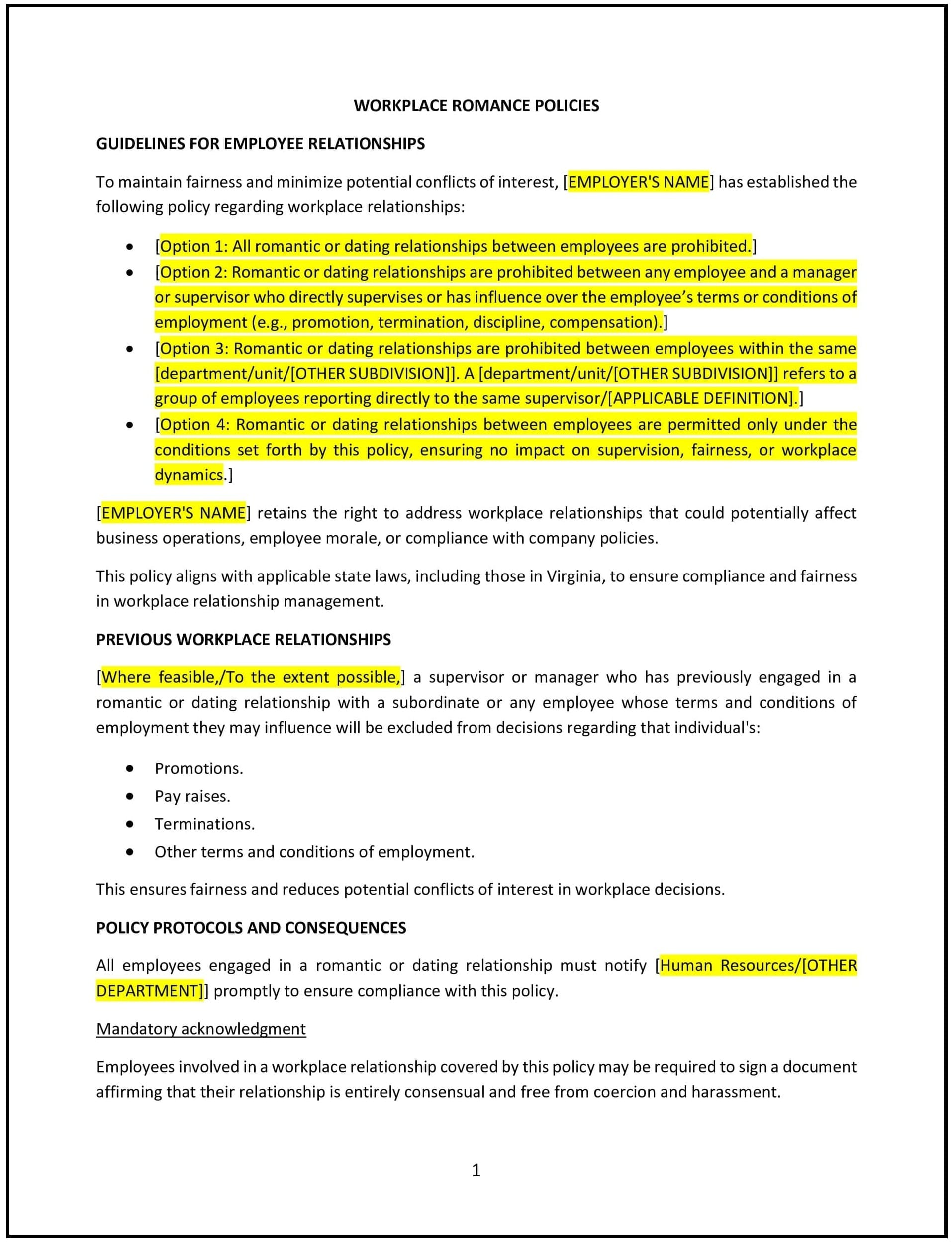Gender transition in the workplace policy (Ohio): Free template

Gender transition in the workplace policy (Ohio)
A gender transition in the workplace policy provides Ohio businesses with guidelines to support employees undergoing gender transition while fostering an inclusive and respectful work environment. This policy outlines the steps to ensure employees are treated with dignity, respect, and fairness throughout the transition process. It includes provisions related to privacy, communication, workplace accommodations, and support during and after the transition. The goal is to create an environment that embraces diversity, minimizes discrimination, and ensures that employees can transition without fear of discrimination or harassment.
By implementing this policy, Ohio businesses can ensure they provide a supportive and welcoming environment for employees undergoing gender transition, enhancing employee well-being, loyalty, and inclusion.
How to use this gender transition in the workplace policy (Ohio)
- Provide guidelines for communication: The policy should set clear guidelines for how the employee’s gender transition will be communicated to colleagues, ensuring the employee’s privacy is respected. It should also explain how to manage the timing of communication and who will be responsible for sharing the information.
- Address confidentiality: The policy should emphasize that any information related to an employee’s gender transition should be treated as confidential and only shared with those who need to know in accordance with the employee’s wishes.
- Offer workplace accommodations: The policy should outline any accommodations that may be necessary during the gender transition process, such as adjusting dress codes, restrooms, or changing facilities to align with the employee’s gender identity.
- Promote respect and inclusivity: The policy should encourage respect for the employee’s gender identity and expression, including using the correct name and pronouns. It should include steps for addressing any discriminatory or harassing behavior.
- Support employee health and wellness: The policy should outline the support available to employees during the transition, including access to counseling, health benefits, and any necessary time off for medical procedures related to the transition.
- Ensure equal treatment: The policy should clarify that the employee will continue to be treated fairly in terms of job responsibilities, performance evaluations, and opportunities for advancement. There should be no discrimination based on gender identity.
- Provide a process for addressing concerns: The policy should establish a process for employees to raise concerns or complaints related to gender transition in the workplace, and clarify how the business will handle these concerns promptly and fairly.
- Review and update regularly: The policy should be reviewed and updated periodically to ensure it reflects any changes in Ohio state laws, federal regulations, or best practices related to gender inclusion in the workplace.
Benefits of using this gender transition in the workplace policy (Ohio)
This policy provides several key benefits for Ohio businesses:
- Fosters an inclusive workplace: By promoting respect and understanding, the policy helps create a work environment where all employees, regardless of gender identity, feel welcome and supported.
- Reduces discrimination and harassment: By setting clear expectations for respectful behavior, the policy helps reduce instances of discrimination and harassment during an employee’s gender transition.
- Improves employee morale and retention: Employees who feel supported and respected during their gender transition are more likely to remain loyal to the business, resulting in higher employee retention.
- Enhances the business’s reputation: A business that is known for being inclusive and supportive of gender transition attracts top talent, improves its public image, and can gain a competitive edge in the marketplace.
- Demonstrates social responsibility: By implementing a gender transition policy, the business demonstrates its commitment to diversity, equity, and inclusion, which can be important to both employees and customers.
- Promotes equality: This policy helps ensure that all employees, regardless of gender identity, have equal access to opportunities and are treated fairly in the workplace.
- Reduces legal risks: By adhering to Ohio state laws and federal regulations, such as Title VII of the Civil Rights Act and the Equality Act, the policy helps mitigate the risk of legal challenges related to discrimination.
Tips for using this gender transition in the workplace policy (Ohio)
- Communicate the policy clearly: Ensure that all employees are aware of the gender transition policy by including it in the employee handbook, discussing it during onboarding, and providing training on inclusivity and gender identity issues.
- Provide training: Offer training to managers, HR personnel, and employees to ensure that everyone understands the policy and is equipped to support employees during their gender transition.
- Be proactive in providing support: Reach out to employees who are undergoing a gender transition to offer assistance with any necessary accommodations, and be sensitive to their individual needs.
- Monitor the work environment: Regularly assess the workplace climate to ensure that the policy is being followed and that there are no signs of harassment or discrimination.
- Ensure confidentiality: Emphasize the importance of confidentiality during the gender transition process, particularly in regard to the employee’s privacy and medical information.
- Adapt workplace policies as needed: Review other workplace policies, such as dress codes or restroom usage, to ensure they align with the employee’s gender identity and provide a comfortable and inclusive work environment.
- Provide resources: Ensure that employees have access to support resources, such as counseling, health services, and employee assistance programs (EAPs), to help them through the transition process.
Q: What should businesses do when an employee informs them of their gender transition?
A: Businesses should respond with understanding and support, ensuring that the employee feels respected and valued. The policy should outline steps for communicating the transition, addressing any needed accommodations, and offering necessary support, such as counseling or medical benefits.
Q: How should businesses address name and pronoun changes during an employee’s transition?
A: The policy should specify that the business will respect the employee’s preferred name and pronouns. All employees should be informed of these changes, and managers should model the correct use of name and pronouns.
Q: Can employees request accommodations related to their gender transition?
A: Yes, employees can request accommodations to support their transition, such as changes to their work schedule, access to gender-neutral restrooms, or adjustments to dress codes. The policy should clarify that such requests will be considered on a case-by-case basis.
Q: How should businesses handle complaints of discrimination or harassment related to gender transition?
A: The policy should provide a clear procedure for addressing complaints, ensuring that all complaints are taken seriously and investigated promptly. The business should make it clear that discrimination or harassment based on gender identity will not be tolerated.
Q: Will an employee’s gender transition affect their job responsibilities or opportunities?
A: No, the policy should clarify that gender transition will not affect the employee’s job responsibilities, promotions, or opportunities for advancement. All employees will be treated equally and fairly, regardless of their gender identity.
Q: Can employees take time off for medical procedures related to their gender transition?
A: The policy should outline the process for requesting time off for medical procedures related to gender transition, specifying any benefits available and how the time off will be treated under the business’s leave policies.
Q: How often should the gender transition policy be reviewed?
A: The policy should be reviewed periodically, at least annually, to ensure that it remains in compliance with Ohio state laws, federal regulations, and current best practices related to gender inclusion in the workplace.
Q: Can businesses limit the number of accommodations they provide during an employee’s gender transition?
A: The policy should specify that accommodations will be provided based on the employee’s needs and the business’s ability to meet those needs without causing undue hardship. The policy should encourage open communication to ensure that accommodations are fair and reasonable.
Q: What should businesses do if an employee faces resistance or discrimination during their gender transition?
A: The policy should outline steps to address any resistance or discrimination in the workplace, including mediation, employee training, and corrective action. The business should make it clear that any form of discrimination or harassment will not be tolerated.
This article contains general legal information and does not contain legal advice. Cobrief is not a law firm or a substitute for an attorney or law firm. The law is complex and changes often. For legal advice, please ask a lawyer.


